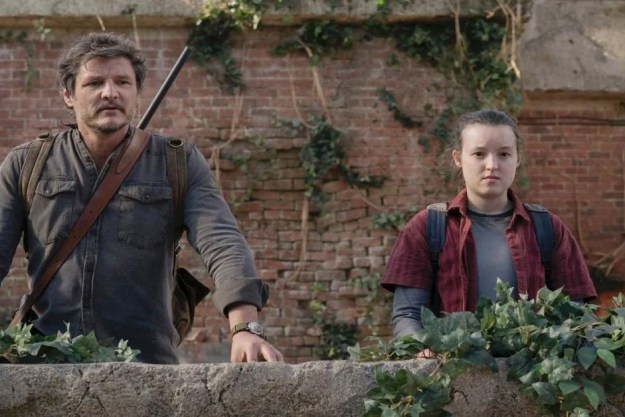The Last of Us may be over for now, but the post-apocalyptic world it created, and the Infected zombie-like monsters that inhabit it, still linger in the memory. While clearly a work of fiction, The Last of Us is effective because of its realism. From its authentic performances by leads Pedro Pascal and Bella Ramsey to its gritty depiction of a world gone mad, the show convincingly creates a reality where the outbreak that occurs at the beginning of the show is entirely possible. But how likely is such a scenario?
Jennings Gabriele is a microbiologist and a teacher with a master’s degree in microbiology and molecular genetics from Oklahoma State University. He’s also a lifelong gamer, having grown up in the 16-bit SNES and Sega Genesis era, who has been playing The Last of Us since it was first released a decade ago on the PS3. Digital Trends sat down with him to discuss the science of The Last of Us, what those creepy tendrils are all about, why fungi are uniquely suited to be the perfect monsters, and how feasible a fungal zombie apocalypse really is.
Note: Spoiler warning for the first three episodes of The Last of Us.
The fung-of-us
Digital Trends: The first episode of The Last of Us begins with a long speech from Dr. Neuman (played by John Hannah) about why he fears that fungi, not viruses or bacteria, are the gravest ecological threat to humanity. He points out how the only thing keeping deadly fungal infections like the ant-zombifying (and real) cordyceps fungus from jumping to humans is an inability for the fungi to survive at our body temperatures, something that could change if the average global temperature were to increase. How accurate is that?
Jennings Gabriele: It’s not accurate. As a microbiologist, I have respect for viruses. I have respect for bacteria. I have no respect for fungi. The only people that get sick from fungi are severely immunocompromised individuals. And it has a lot to do with the cellular and chemical makeups of the human body. There’s probably nowhere more inhospitable to fungi than the human body.
Why is that? What makes us worse hosts than ants, for example?
We are really big, which means we have an unfavorable surface area-to-volume ratio and retain a lot of heat. Fungi can cause surface-level infections because they’re basically decomposers. If you have poor hygiene and a lot of dead skin, you could get a yeast infection, ringworm, athlete’s foot, and those types of things. But it has a really hard time reaching your organ systems. There’s no method for them to move throughout the body if punctured through the skin.
Every weakness a fungus could have is maximized inside the human body.
They also need a lot of oxygen. It sounds kind of weird to understand because we breathe oxygen. If we don’t have oxygen, we die very quickly. But in your body, there’s no free-floating oxygen. It’s all tied up in the iron, the hemoglobin. So they have no easy access to oxygen. And going beyond that, they need all that oxygen to do a type of respiration where they basically burn carbon using oxidative respiration.
And there’s the human immune system. It is really capable of doing an oxidative immune response. Our immune system can produce these things called peroxisomes, and other oxidative chemicals, that will pull electrons away from whatever is attacking it, whether it be bacteria, viruses, or fungi. When they pull the electrons away, the funguses are not able to do their metabolism, and they basically die really quickly and really easily.
Every weakness a fungus could have is maximized inside of the human body. That’s why you probably have never heard of somebody dying or getting very sick from a fungal infection. Our bodies are just naturally not conducive until you get to late-stage AIDS patients or late-stage cancer, radiation treatment, those type of things.

It’s indicated pretty heavily in the show that the fungal outbreak was initially spread via worldwide shipments of flour. Jakarta, Indonesia, is featured in the opening of the second episode as ground zero since it has the world’s largest flour mill, and the first infections are found in a flour factory. Let’s say we do encounter some sort of fungus that does find humanity to be a hospitable host. Could it be spread via the food supply?
Yes. I mean, I’d be surprised if our flour supply is not tainted with funguses right now. The thing about the show is that they make it seem like humans aren’t at war with fungi. We are at war with fungi, just in the agricultural sphere. Fungi are trying to kill plants all the time, especially crops. We’re constantly at war with them in that realm, just not in our immune system. So that is a very common thing, that funguses will infect crops.
We are at war with fungi, just in the agricultural sphere.
The Food and Drug Administration (FDA) and food manufacturers aren’t really that concerned if it gets into the food supply. It’s completely plausible that you would have fungal spores and fungal infection spread. When you think about agriculture, you’re talking about a crop that sits there for several weeks. Wheat usually takes like six to 10 weeks to grow before it gets harvested. And then it sits in a silo for several more weeks. And if it rains, it gets wet. You know, that all breeds fungus and mold and stuff. And then it gets processed into flour.
They don’t disinfect it when they process flour. You get what’s left over. And if it’s not horribly contaminated, you won’t notice. The solution to pollution is dilution. I would be surprised if, right now, our flour did not have quite a bit of fungal material on it to begin with. But the good news is that it’s all dried out. Fungus literally can’t grow without water, and there’s nothing more dry than flour. It’s super-dry stuff.

Is it true that there could not be a vaccine or drugs to treat catastrophic fungal pandemic?
Absolutely not. I think there would easily be a vaccine. Our bodies make antibodies, which bind to stuff in that way our immune system recognizes stuff to fight it off. When I see all those fungal structures that you see in the show, and then the game, I see a bunch of antigens. If anything, I think it’d be more likely that you would get an allergic reaction, and that might kill. Like in the game, all those spore sections, if you took a deep breath, and if you had no immunity built up, you’d probably have like anaphylactic shock, and you know, die.
It is harder to make drugs for funguses because they’re more similar to humans than bacteria are. But also, there are just a ton of fungicides. [In the show], they said they should bomb Jakarta. They should make it rain pesticides that kill fungus. Instead of spraying a cornfield, just spray the city. That would be really easy. It was obviously hyperbolic, because it needs to set up stakes for the show, but I shrug my shoulders. There’s actually a lot of stuff we could do. But without that, there’s not the apocalypse and the drama.
Yes, those creepy tendrils are real
In The Last of Us video games, the infection spreads via spores. But for the HBO adaptation, they spread via these tendrils. Are those real things?
They are. You actually see them all the time. Whenever you look at molded fruit, the little fuzzy part of the fruit is these little mycelia sticking out. They’re microscopic, so it looks like super-fine hair. But that’s what it is, these little mycelia sticking out. Fungi everywhere make these mycelia.
We see them coming out of the mouth, and rather than spores infecting the body and taking a day or whatever to turn somebody, they kind of burrow their way through the body to the new host.
They serve two purposes, usually. They move a fungal organism in a direction. Fungi can’t walk around, they don’t have flagella like sperm does, with that little tail that can zoom around. So that’s one way they can move toward a new location. So it’s kind of like a weird locomotion type thing, and it allows them to get resources from other areas.
And also, it can connect other parts, where you can have bigger connections of other fungi and have one really big fungal organism, like what we would call a mushroom. Most fungi are actually really microscopic. And mushrooms are like these little really special structures that are kind of rare for funguses.

Can the mycelium be used to actually propagate or spread the fungus?
The cool thing about fungi is that they reproduce in some of the most complicated varieties possible. A lot (of other types) of cells can clone themselves or do sexual reproduction. But fungi have some of these crazy reproductive strategies where they can do asexual reproduction. They can do sexual reproduction. They can do asexual spore reproduction, they can do sexual spore reproduction, they can do mycelium, where basically they kind of clone themselves, like oak trees can clone themselves with plant roots underground. They can do all kinds of crazy stuff and be the same organism.
That’s kind of how it ties into the show. You see those mycelia. We see them coming out of the mouth, and rather than spores infecting the body and taking a day or whatever to turn somebody, they kind of burrow their way through the body to the new host. They’ll go up to the mouth and the next person, ready to infect the next potential host.
So, this is more like a parasitic worm taking over the brain. This makes sense because no microbial infection could replicate fast enough to overtake the brain in the short time people turn in the TV show. But a fully developed parasite could travel to the mouth and be prepared to spread to the next host. You could argue it either way, but the bite would have to be necessary for such a large inoculating dose that it quickly causes symptoms.
So is the mycelia we see spreading throughout buildings and cities something that fungus will actually do?
Yeah, absolutely. In reality, it’s slow and happens over several hours to several days. In the show, they move really quickly. I never see mycelium move like that in real life, but it looks pretty cool and kind of scary. And it solves one issue as a microbiologist I have with zombie shows. No infection causes symptoms in the time it would take to have that anxiety that somebody is going to turn really quickly. We’ve all been around sick people, and then we get sick two, three days later.
But as a microbiologist, if you put a worm or mycelia tendril into somebody, it could move around throughout the body. It does not necessarily have to go through an entire infection cycle, because it’s just basically a separate organism that’s kind of moving within your body. It can be along for the ride.
In the show, the infected are all interconnected. If I touch something here, that gets communicated through some kind of fungal throughline. Is there any truth to that concept?
There is truth to it. I’ve spoken to mycologists who call these superorganisms, but they’re probably stretching your common definition of what an organism is. It’s more like an interconnected community of the same fungus. They don’t really share resources. They just kind of communicate with each other, and they can get really, really big.
You know on the show when there’s that one part where it’s like they trigger the horde? You know, it almost felt like it was like a horde mode in a game. They almost made it seem like it’s a superorganism with a kind of hive mind. What I see is, there’s agitation, and then they go towards the agitation, which is a lot more evolved and realized than what you actually see in real life.
We see many different forms of the infected, like Clickers and Bloaters, in the game and HBO series. Is that something a single fungus could do?

And they’re all the same species, they’ll all be the exact same organism, it’s just based on their environment and what’s best for them. In the game, when they bite somebody, they are spreading the yeast version of it, because of all fungi that can possibly infect humans, it is always the yeast that does it. We don’t get infected by any other parts.
The more I learned, the more the concept of fungus for level design and enemy design actually does lend itself really well.
That’s the thing I like. And I remember playing the game the first time when I was still an undergrad. When the game first came out, I had already taken a plant pathology course, so I knew somewhat about mycology. And the more I learned, the more the concept of fungus for level design and enemy design actually does lend itself really well, because they can do all this other weird stuff. That’s what makes fungi so unique is that they can adapt to these different situations really well and do cool stuff that no other organisms really can.
All right, Mr. Gabriele, as a teacher, you need to give The Last of Us TV show a letter grade for its science so far. What are you going to give it?
I’m a pretty easy teacher. I take it as a general studies, I don’t take it too seriously as I want people to know just a tiny little bit. So I would give it a B. I love the fact that somebody is just even passionate about fungi.
All nine episodes of season 1 of The Last of Us are currently streaming on HBO Max.
Editors' Recommendations
- Kaitlyn Dever cast as Abby in The Last of Us season 2
- 8 actors who could play Abby in The Last of Us season 2
- The Last of Us season 2 may fix The Last of Us Part II’s biggest flaw
- I just finished The Last of Us and loved it — here’s what I’m watching next
- Why The Last of Us is better as a TV show than a video game




